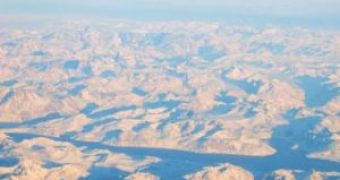Greenland's massive ice sheet is melting much more quickly than scientists had estimated, according to data gathered by NASA satellites. The rhythm of ice loss increased by 250 percent during May 2004 to April 2006 relative to the period from April 2002 to April 2004, according to CU-Boulder researchers Isabella Velicogna and John Wahr. "Two hundred and fifty percent is huge," said Isabella Velicogna, an earth scientist at the NASA Jet Propulsion Laboratory in Pasadena, California.
Greenland lost roughly 164 cubic miles of ice from April 2004 to April 2006 (more than the volume of water in Lake Erie), while the loss between 2002 to 2004 was of 57 cubic miles. "The speed-up in ice mass loss charted by the researchers has been occurring primarily in southern Greenland," said Velicogna.
Ice retreat is now of 59 cubic miles (248 cubic kilometers) a year, enough to rise global sea levels up 0.02 inch (0.5 millimeter) a year. "It was losing quite a bit of mass before 2004 but there is a very strong acceleration, which means things are changing,". "It is more than we have been observing in the last century."
"Studies by several research groups indicate temperatures in southern Greenland have risen by about 4.4 degrees F in the past two decades", said Velicogna.
The decrease does coincide with a warming climate and independent observations of increased glacier ice loss in the island. "This leads us to think this [mass loss] is probably associated with ice discharge," Velicogna said.
"The CU-Boulder findings also are consistent with studies charting a dramatic acceleration of the Kangerdlugssaq and Helheim glaciers in southeast Greenland using satellite radar observations," said Wahr.
A 2006 study by researchers at the University of Wales showed that the two glaciers have doubled their speed and are throwing twice as much ice into the sea as they did five years ago. Konrad Steffen, who has maintained more than 20 climate stations in Greenland for nearly two decades, said temperatures have risen by more than 4 degrees F along the western slope of its ice sheet since 1990. "The increased surface melt of snow and ice provides additional melt water to lubricate the bottom of the ice sheet and increases the ice flow velocity toward the coast," said Steffen, a CU-Boulder geography professor.
"Even if temperatures suddenly drop in Greenland the discharge would continue for several years." says Velicogna.
"Greenland harbors about 10 percent of the world's freshwater in its ice sheet, which is up to two miles thick in places. It is so huge that if it melted entirely sea levels across the world would rise by about 20 feet (7 m)", Tavi Murray of the University of Wales in Swansea said.
In March 2006, Velicogna and Wahr used NASA satellites to determine that the Antarctic ice sheet (which holds 70 percent of Earth's freshwater) lost up to 36 cubic miles of ice annually from April 2002 to August 2005. "Significant ice loss in Greenland has the potential to have severe effects on the climate of the Northern Hemisphere", said Velicogna.
Large amounts of freshwater from Greenland's eastern coast could help to weaken the counterclockwise flow of the North Atlantic Current, lowering water and wind temperatures and potentially cooling the climate of northern Europe. Velicogna adds that - if temperatures continue to rise - the ice loss could also affect northern Greenland.

 14 DAY TRIAL //
14 DAY TRIAL //